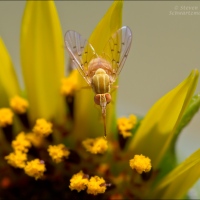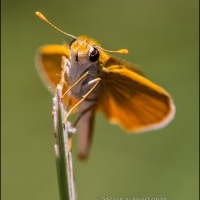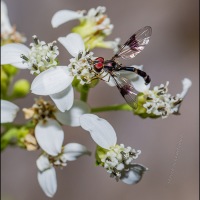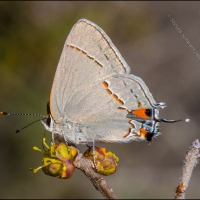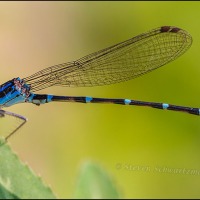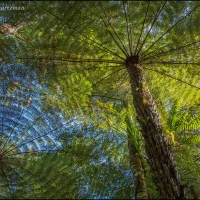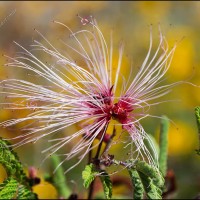Posts Tagged ‘Austin’
Purple amidst all the red and yellow
For some years now I’ve noticed mealy blue sage (Salvia farinacea) coming up each spring at the southwest corner of Burnet Rd. and Shoreline Dr. in far north Austin. On April 29th I stopped there to take advantage of the particularly dense colony of firewheels (Gaillardia pulachella) that had surrounded the sage.
§
§ § §
§
Public service announcement
You’ve probably heard from time to time about how scammers bilk people out of money. One scheme that’s been worked on older people is to contact them claiming to be a grandchild who’s in trouble and desperately needs money to get out of a jam. That gambit is likely to increase because with advances in artificial intelligence (AI), scammers can make fake videos and audios that look and sound just like the real person that the target of the scam knows.
As good citizens we should make people, especially older people, aware of that kind of scam. Even better, we should give them a defense. It occurred to me that anyone who gets contacted by somebody claiming to be a relative or friend in trouble should ask a question that only the real person would know the answer to. Examples are:
- Where did we vacation in 2005?
- What kind of pet did you have in junior high school and what was that pet’s name?
- What country did your mother’s mother immigrate from?
- You used to eat two foods together that everyone thought was a strange combination. What were they?
The more particular and unusual the question, the better. If the supposed relative or friend who’s in trouble doesn’t immediately answer or dodges and makes excuses for not being able to answer (“I’m so stressed out I can’t think straight”), that’s almost certainly evidence of fraud.
If you know someone you think might be vulnerable to that kind of scam, pass this advice along.
© 2024 Steven Schwartzman
Barbara’s buttons
On April 29th I photographed not only in the median of the Capital of Texas Highway in my Great Hills neighborhood but also by the edge of the highway a couple of miles southwest. One subject was a little colony of Barbara’s buttons, Marshallia caespitosa. The top picture shows you I wasn’t the only visitor. Below, you get a better view of one of the flower heads in its own right.
§
§ § §
§
Today, Western societies continue to torture themselves over their histories of colonialism and imperialism, while allowing antisemitic, genocidal thugs and their apologists free rein on our streets, barely 80 years after the Holocaust. The disciples of bin Laden smile as Gen Z TikTokkers idiotically praise his evil rantings. The woke revolutionaries who have infiltrated our institutions seek to tear down the civilizing work of centuries.
Unless October 7 is the beginning of a reversal of Europe’s and America’s creeping cultural suicide, Islamism will prevail. We must sound the alarm, restating the Judeo-Christian values that have benefited us all so much. We must be loud in speaking up against the wrongheadedness of the go-along-to-get-along policies of our elites, and elect leaders who understand the West’s existential crisis and are willing to address it. We must champion our Western civilizational heritage and show Gen Z that the world built up over centuries by Western values is infinitely superior to the hellish dystopian vision of the Islamists.
In short, we must fight for our values wholeheartedly and unashamedly. Only then might we save the West. I have seen the alternative: I have lived in that Islamist dystopia. The wonderful cultures I found in 1992, which have immeasurably improved my life, are vanishing before our very eyes as our society’s terrible mistakes lead us to the Islamist precipice. Let October 7 be a spur to us to act before it is too late.
That’s the ending of a cautionary speech that Ayaan Hirsi Ali gave in December 2023, which I encourage you to read from the beginning. Unfortunately things have gotten worse since then.
© 2024 Steven Schwartzman
More from close to home
From the median of the Capital of Texas Highway that borders my Great Hills neighborhood, here are more pictures of the wildflower extravaganza I documented there on April 29th. The yellow-fringed red flower heads are Indian blankets (Gaillardia pulchella). The yellow flowers are Engelmann daisies (Engelmannia perstenia) and the brown ones are Mexican hats (Ratibida columnifera). A few violet-colored silverleaf nighshade flowers (Solanum elaeagnifolium) were mixed in. Nearby, old plainsman (Hymenopappus scabiosaeus) stood out and some greenthreads (yellow, Thelesperma filifolium) joined the mix.
§
§ § §
§
Migrants [i.e. people who entered the United States illegally] in Denver on Monday submitted a list of 13 demands that they say the city must meet before they leave their packed encampment and head into shelters. The group refused to budge until their extensive list… is met….
That’s from a May 9th article by Alec Gearty in the New York Post. The article lists the 13 demands:
- Migrants will cook their own food with fresh, culturally appropriate ingredients provided by the City instead of premade meals — rice, chicken, flour, oil, butter, tomatoes, onions, etc. … Also people will not be punished for bringing in & eating outside food.
- Shower access will be available without time limits & can be accessed whenever — we are not in the military, we’re civilians.
- Medical professional visits will happen regularly & referrals/connections for specialty care will be made as needed.
- All will receive the same housing support that has been offered to others. They cannot kick people out in 30 days without something stable established.
- There needs to be a clear, just process before exiting someone for any reason — including verbal, written & final warnings.
- All shelter residents will receive connection to employment support, including work permit applications for those who qualify.
- Consultations for each person/family with a free immigration lawyer must be arranged to discuss/progress their cases, & then the City will provide on-going legal support in the form of immigration document clinics & including transportation to relevant court dates.
- The City will provide privacy for families/individuals within the shelter.
- No more verbal or physical or mental abuse will be permitted from the staff, including no sheriff sleeping inside & monitoring 24/7 — we are not criminals & won’t be treated as such.
- Transportation for all children to & from their schools will be provided until they finish in 3 weeks.
- No separating families, regardless of if family members have children or not. The camp will stay together.
- The City must schedule a meeting with the Mayor & those directly involved in running the Newcomer program ASAP to discuss further improvements & ways to support migrants.
- The City must provide all residents with a document signed by a City official in English & Spanish with all of these demands that includes a number to call to report mistreatment.
Like I said, chutzpah.
© 2024 Steven Schwartzman
Much closer to home
After 8 hours and 250 miles of wildflower hunting west of Austin on April 23rd, I lay low for almost a week. Not till the 29th did I head out with my camera again, initially “only” to a part of the Capital of Texas Highway that borders my Great Hills neighborhood. I put “only” in quotes because the highway median was actually quite a floral extravaganza, as you see here.
The yellow-fringed red flower heads are Indian blankets (Gaillardia pulchella). The prominent purple flowers are silverleaf nighshade (Solanum elaeagnifolium). You see them in the distance in the top picture, and a group of them closer below. A few Mexican hats (brown, Ratibida columnifera) are mixed in.

§
§ § §
§
You have to watch/read the moving speech “What It Means to Choose Life” that Douglas Murray gave when he accepted the Manhattan Institute’s Alexander Hamilton Award on May 6th. You’ll find out some of the things he experienced in Israel beginning right after Hamas’s slaughter of innocents seven months earlier.
© 2024 Steven Schwartzman
Dense Texas thistle colony
From April 22nd at the Wildhorse Ranch subdivision in Manor,
how about this dense colony of Texas thistles (Cirsium texanum)?
§
§ § §
§
The Oversight Board of Meta, the parent company of Facebook, is reviewing whether Facebook should keep letting users post slogans like “From the river to the sea, Palestine shall be free,” which have proliferated since October 7, 2023, after Hamas slaughtered 1200 people in Israel, torturing and raping many of them in the process, and continuing the mayhem by taking over a hundred hostages. In deciding whether Facebook should still allow such slogans or should ban them, the Oversight Board is soliciting public comments through May 21st. You can follow that link to submit a comment if you’d like.
A friend alerted me to this yesterday, and here’s the comment I left:
Many people repeating the chant “From the river to the sea, Palestine shall be free” have no idea what river and what sea they’re chanting about, nor what the implications of the chant are. The river is the Jordan, and the sea is the Mediterranean. The slogan means that Palestine will be free of Jews everywhere between those two bodies of water, which is to say everywhere that the modern state of Israel exists. Whether the Jews who live there now are to be “merely” expelled or outright murdered, the chant doesn’t specify. Either way, the fulfillment of the slogan entails committing millions of individual crimes.
Facebook has three choices. One is to do nothing and let users keep posting the slogan. That perpetuates the call for the expulsion or killing of the people in a sovereign nation, and is therefore not a just course of action.
A second option is to ban the slogan and all variants of it. That eliminates the particular call for the expulsion or killing of the people in a sovereign nation, but it comes at the expense of Facebook users’ desire to express themselves.
A third choice, and the one I recommend, is that whenever a user cites slogans like “From the river to the sea, Palestine shall be free,” Facebook should attach an explanation containing the substance of what I said in my opening paragraph. That way everyone who reads a post containing those slogans will know specifically what’s being called for: the commission of millions of crimes by expelling or killing the people in a nation. In order to do something about such a dangerous threat, we have to know that the threat is being made and who is making it.
© 2024 Steven Schwartzman
Nothing anomalous
Several self-sown stands of Tinantia anomala, known as widow’s tears and false dayflower, now reside in our back yard. The view above is from April 20th, as is the portrait below of a straggler daisy, Calyptocarpus vialis. A yellow flower head of this species is about a quarter of an inch (6mm) in diameter.
§
§ § §
§
The website USCourts.gov, reporting on the 1941 Supreme Court case Cox v. New Hampshire, 312 U.S. 569, describes the issue in that case as “whether time, place, and manner restrictions on holding a parade violate the First Amendment.” In its summary of the case’s resolution, the website notes: “A unanimous Supreme Court, via Justice Charles Evans Hughes, held that, although the government cannot regulate the contents of speech, it can place reasonable time, place, and manner restrictions on speech for the public safety. The Court held that the New Hampshire law was not meant to prohibit speech, but simply to regulate it when it took the form of a parade or other form of large gathering.”
With that precedent in mind, yesterday I mailed a letter to the President of Columbia University. I identified myself as a graduate and said how appalled I was by the recent events there. Then I went on as follows:
In Cox v. New Hampshire, 312 U.S. 569 (1941), the U.S. Supreme Court decided 9-0 to uphold the principle that governmental entities may impose reasonable restrictions on the time, place, and manner of people’s speaking. That applies a fortiori to a private institution like you, my alma mater, Columbia University. I am calling on you to adopt a set of reasonable restrictions on demonstrating that include at least the following.
No demonstrator may impede or try to impede any other person from moving freely about the campus. No demonstrator may obstruct any pathway, roadway, sidewalk, gate, doorway, corridor, steps, or other means of access to any part of the campus.
No demonstrator may block access to or shout down a scheduled activity like a class, an exam, a presentation by an invited speaker, or a graduation ceremony.
No demonstrator may wear a mask or anything else that keeps onlookers from seeing the demonstrator’s face. (Anyone who claims to be immuno-compromised may stand outdoors in fresh air 10 feet away from other people.)
No demonstrator may create any sort of encampment or put up a tent or erect any type of structure.
No demonstrator may move closer than 10 feet to a non-demonstrator, nor may a demonstrator follow any non-demonstrator.
No demonstrator may bring, carry or deploy as part of a demonstration an object larger than 18 inches in any dimension. That includes but is not limited to signs, poles, boards, banners, flags, and umbrellas. No sign may be on a stick or pole. No demonstrator may attach a sign or banner to any structure.
No demonstrator may use a bullhorn, loudspeaker, or any other sound-amplification device, nor may a demonstrator use a noisemaker, drum, musical instrument, or any other device that creates sound.
The above rules must be rigorously enforced. A member of the Columbia community—including students, faculty, administrators, staff, and alumni—found to have violated any of the above rules shall receive a warning upon a first offense. Upon again violating any rule, which needn’t be the same rule as before, the violator shall be given a suspension of at least one week. After a third offense, expulsion or termination of employment shall be the penalty. A violator who is not part of the Columbia University community shall be referred to authorities for criminal prosecution on charges of trespass, criminal mischief, disorderly conduct, and the like. And of course if any person, whether part of the Columbia community or not, violates a criminal law, University authorities must immediately call in the police.
It took several days to put the letter together. Will it do any good? Probably not, but I felt I had to send it.
© 2024 Steven Schwartzman
When is a leaf not a leaf?
An old riddle, which should be spoken rather than read, asks: when is a door not a door? The answer: when it’s ajar. I don’t have anything as verbally clever as that for you today, but I hope you’ll agree that the natural rock formation above that I found in Springfield Neighborhood Park on April 2nd does look like a dry leaf. I leave it to your imagination if it wants to make something of the natural formation below, which lay a few steps away from the first one.
Also close by, rock layers curved more broadly.
§
§ § §
§
… The enthusiasm of leftist professors and students for the Islamic Resistance Movement in Gaza is unprecedented in the history of modern leftism. Scepticism and even outright rejection of what Marx called “the opiate of the people” has been a salient theme of leftist sensibilities since the French Revolution. Yet Hamas’s punishing fundamentalism has not deterred the secular American Left from embracing what I have called “fascism with a religious face.” Over the past decade, I have drawn attention to the emergence of the pro-Hamas Left, and to the bizarre fact that secular intellectuals and students are now supporting an organisation that grew out of the Muslim Brotherhood and Nazi collaborators. Today, the Islamisation of the Left has become unignorable on college campuses.
As its foundational Covenant made clear in 1988, Hamas’s reactionary nature lies in a selective reading of Islam’s ancient texts that defines the religion as inherently antisemitic. This interpretation of Islam legitimises Hamas’s religious war to destroy the state of Israel, its rejection of liberal democracy, its use of terror as a political weapon, and its social conservatism that demands the subordination of women and lethal hostility to homosexuality. All of which ought to make Hamas anathema to social progressives on the academic Left. But the enthusiasm with which secular anti-Zionists have rallied to the cause of Hamas’s religious warriors—or at least protected them from criticism—suggests that solidarity in their shared hatred of a common enemy, Israel, supersedes all other political differences.
You can read Jeffrey Herf’s full May 2nd article “Springtime for Sinwar,” whose subtitle is “Notes on the pro-Hamas Left and its antecedents.”
© 2024 Steven Schwartzman
Opening wildflowers portrayed with light and shadows
An April 2nd morning walk through Springfield Neighborhood Park yielded abstract portraits of two opening wildflowers, the scarlet leatherflower (Clematis texensis) above and the buttercup (Ranunculus sp.) below, in both of which the contrast between dark and light created a colorful chiaroscuro. Clicking enlarges each view.
§
§ § §
§
In a social experiment, a couple friends and I went to a Pro-Palestine protest in NYC with just American flags. The protestors’ reactions were truly shocking. Two of our flags were lit on fire and one was stolen. They praised Osama Bin Laden and chanted “death to America” This is not just a fight for Israel. This is a fight for America!
You can watch David Lederer’s 3.6-minute video showing those things.
It’s appalling what some of the people in my country have turned into.
© 2024 Steven Schwartzman
A study in scarlet* (and green and black)
A post four days ago revealed that on the morning of April 2nd I went wandering through Springfield Neighborhood Park in southeast Austin. After several coral honeysuckle flowers (Lonicera sempervirens) along the path beckoned to me I heeded their colorful call and was pleased with some of the abstractions I came away with. While photographers often consider the shadows that flash casts a defect, in this case I found the shadows enhanced the composition by adding radiating linear black elements that not only echo the flowers’ red ones but also simultaneously create a third set of alternating green ones.
* Shades of Holmes and Watson
§
§ § §
§
With elections in the United States already contentious, the group called Braver Angels has issued a “Trustworthy Elections Report,” which outlines what it identifies as seven broad areas of concern:
Fair and Equal Access to Voting: Today, some citizens encounter significant barriers to voting,
while other citizens find few, if any, impediments. Our election process should strive to remove
barriers so that each citizen has an equal and reasonable opportunity to cast their vote.
Verifiable Voter Identity and Eligibility: There is some evidence, although rare, that some
voters are misrepresenting their eligibility to vote. Voters should be required to identify
themselves and prove their eligibility before casting a ballot.
Transparency and Accountability: Every citizen should be able to understand the election
process. There must be reasonable opportunities to observe election activities. The processes
related to training poll watchers and civics education should be based on best practices.
Redistricting – Gerrymandering: Voters should be able to decide who they want to govern
them. Instead, today, politicians and special interest groups draw gerrymandered redistricting
maps, through which they pick their preferred voters instead of the other way around. This
practice must end.
Confidence in Vote Counting: Every legal vote should be counted as accurately as possible.
Checks and backup documentation must be in place so that voters are assured that vote counts
are complete, accurate and unbiased.
Safety and Security in the Elections Process: Everyone involved in administering elections
must be able to do so safely and without fear of intimidation. Election processes must have robust
defenses against fraud and interference.
Peaceful Transfer of Power: Americans will not trust the outcome of elections if their leaders
sow the seeds of doubt. Candidates must ultimately accept the results of elections, provided there
is a robust process to resolve disputes. Violence must never be used to decide an election in the
United States.
You can read the report for the details of 23 specific solutions the group proposes.
© 2024 Steven Schwartzman
Return to the Merrilltown Cemetery
Having stopped at the old Merrilltown Cemetery on March 19 to photograph wildflowers and tombstones, I returned 11 days later. The expanse of wild garlic flowers (Allium drummondii) seemed even lusher than on my previous visit. In particular, I’d gone back to see if the rain lily (Zephyranthes drummondii) leaves I’d noticed the first time had been followed by flowers. Though not nearly as many had come up as I’d wished, enough had for me to make portraits of some buds and flowers.
As I was finishing up my photographic business, several men with weed whackers walked in from an adjacent property and began to go about their different sort of business. My hope was that they’d clear a few paths and leave most of the wildflowers alone. Ah, of course I should have known better: when I drove past the cemetery a few days later I couldn’t see a single wildflower.
❦
❦ ❦ ❦
❦
My commentary three days ago described how Uri Berliner, a “progressive” who has worked at NPR (National Public Radio) for more than two decades, wrote an article criticizing how politically one-sided the organization, which gets part of its funding from American taxpayers, has become. For example, he described how,
… Concerned by the lack of viewpoint diversity, I looked at voter registration for our newsroom. In D.C., where NPR is headquartered and many of us live, I found 87 registered Democrats working in editorial positions and zero Republicans. None.
So on May 3, 2021, I presented the findings at an all-hands editorial staff meeting. When I suggested we had a diversity problem with a score of 87 Democrats and zero Republicans, the response wasn’t hostile. It was worse. It was met with profound indifference. I got a few messages from surprised, curious colleagues. But the messages were of the “oh wow, that’s weird” variety, as if the lopsided tally was a random anomaly rather than a critical failure of our diversity North Star.
Well, yesterday “diversity” won out: NPR suspended Uri Berliner for five days.
© 2024 Steven Schwartzman


















